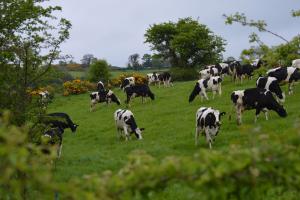AFBI research aims to maximise milk from grass
Date published:
A recent study at the Agri-Food and Biosciences Institute (AFBI) at Hillsborough examined the impact of altering the yield of milk assumed to be sustained by grazed grass on dairy-cow performance during the grazing season.

Background
Achieving high intakes of grazed grass remains an important target on most dairy farms due to the lower cost of grazed grass compared to purchased concentrate feed. However, due to the increase in the milk production potential of dairy cows in Northern Ireland in recent years, grazed grass offered as the sole feed is often insufficient to meet the energy requirements of higher yielding cows during the grazing season.
As a consequence, dairy cows are normally offered concentrates to support milk yields above those that can be supported by grazed grass alone.
In practice, concentrate feed levels on many farms are calculated by assuming that grazed grass can support cows’ energy requirements for maintenance plus a given level of milk production (the ‘maintenance plus’ value). For example, a ‘maintenance plus’ value of 25 litres means that it is assumed that grazed grass can support the cow’s energy requirements for maintenance plus 25 litres of milk per day. Concentrates are then offered to support milk yields above this ‘maintenance plus’ value, with concentrates offered either on a ‘feed-to-yield’ basis for individual cows or on a ‘flat-rate’ basis across the herd.
Previous studies at AFBI Hillsborough have demonstrated that when offered as the sole feed, grazed grass can sustain milk yields of up to 27 litres per cow per day in late May, with this value declining to 14 litres per cow per day by late September. However, when concentrates are offered to grazing cows, grass intakes normally decrease (the ‘substitution effect’), and consequently the yield of milk that is sustained by grazed grass is reduced. Obtaining improved information on optimum ‘maintenance plus’ values is essential to prevent cows from being either underfed or overfed concentrates.
AFBI Hillsborough Research
The current study, which was jointly funded by DARD and AgriSearch, was conducted during the 2013 grazing season and was designed to examine the effect of assuming different ‘maintenance plus’ values during the grazing season on cow performance and concentrate supplementation. The study ran from 24 May to 2 October and involved a total of 72 cows (including 24 heifers), which had an average calving date of 21 December (2012).
Cows were managed on one of three ‘maintenance plus’ treatments (‘Low’, ‘Medium’, or ‘High’), which are summarised in Figure 1. The ‘maintenance plus’ values for cows on the ‘High’ treatment were based on previous research studies conducted at Hillsborough in which cows were fed grazed grass as the sole feed throughout the grazing season, while the values for the ‘Medium’ and ‘Low’ treatments were set at 85% and 70%, respectively, of those for cows in the ‘High’ group. With the heifers, the ‘maintenance plus’ values were set at 80% of the values used for the cows.
The three treatment groups were grazed in adjacent paddocks to the same post-grazing sward height (target of 5 cm). Concentrates were offered on a ‘feed-to-yield’ basis, with the concentrate allocation for each cow adjusted every two weeks based on the actual milk yield of each cow during the previous two weeks and the current ‘maintenance plus’ value assigned to the cow. Concentrates were then allocated to individual cows at a rate of 0.45 kg for every litre of milk produced above the ‘maintenance plus’ value.
Results
As ‘maintenance plus’ decreased (from ‘High’ to ‘Medium’ to ‘Low’), the quantity of concentrates offered (using a ‘feed-to-yield’ approach) increased, while daily milk yields per cow per day and daily milk yields per hectare of area grazed also increased (Table 1). There were no differences in milk fat or protein content between the three treatment groups. However, cows in the ‘Low’ treatment group had greater body condition scores and live weights at the end of the study, compared to those in the ‘Medium’ or ‘High’ groups. Thus, placing a high reliance on grazed grass resulted in thinner cows at the end of the study. If the body tissue reserves of these cows cannot be restored during the late lactation period, these thinner cows may have an increased risk of health problems during the dry period and the subsequent lactation. Total concentrates offered during the study were 242, 408, and 645 kg per cow for the ‘High’, ‘Medium’, and ‘Low’ treatments, respectively, while the corresponding stocking rates were 6.5, 7.0, and 7.7 cows per hectare (based on grazed area only).
A simple economic analysis indicated that the daily margin-over-concentrate value per cow (calculated assuming an average base milk price of 35.1 pence per litre (including compositional bonuses) and a concentrate feed cost of 25 pence per kilogram) increased as the reliance on grazed grass decreased. However, under a scenario of lower milk price and/or higher concentrate cost, the economic advantage of the ‘Low’ treatment will be reduced.
Conclusions
The results of this study demonstrated that placing high reliance on grazed grass within a feed-to-yield system (by assuming a high ‘maintenance plus’ value) resulted in reduced concentrate usage, but this was accompanied by lower daily milk yields and lower cow body conditions at the end of the study. The economic profitability of each of the three treatments will be determined by current milk price and concentrate cost.
by Peter Purcell, Andrew Dale, and Conrad Ferris, AFBI Hillsborough
Notes to editors:
AFBI carries out high quality technology research and development, statutory, analytical, and diagnostic testing functions for DARD and other Government departments, public bodies and commercial companies. AFBI's Vision is “Scientific excellence in Northern Ireland … serving the world”.All media enquiries to AFBI Press Office.